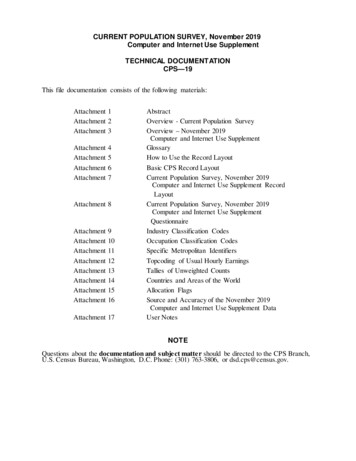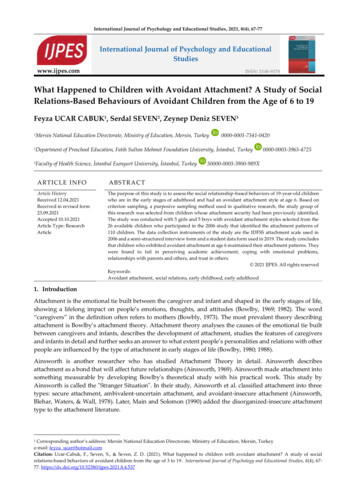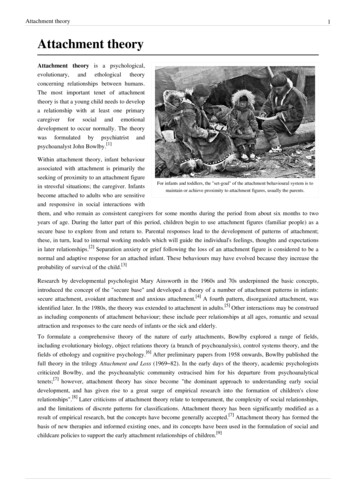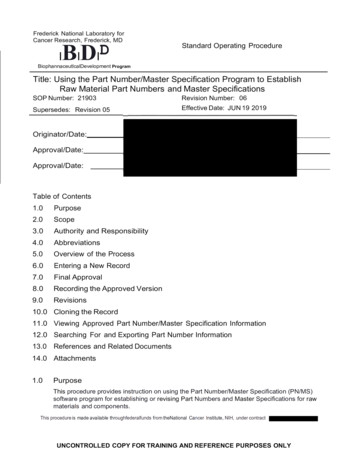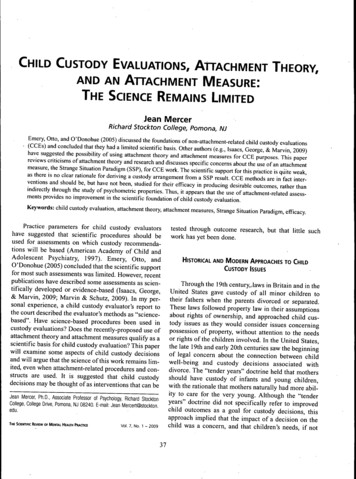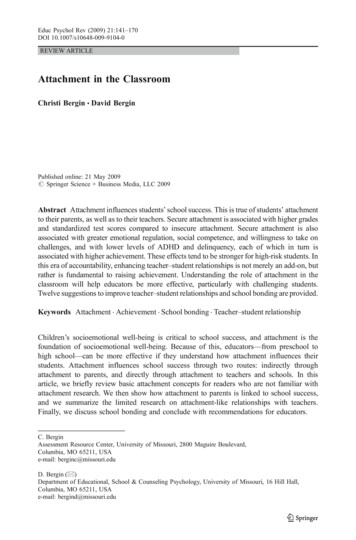
Transcription
Educ Psychol Rev (2009) 21:141–170DOI 10.1007/s10648-009-9104-0REVIEW ARTICLEAttachment in the ClassroomChristi Bergin & David BerginPublished online: 21 May 2009# Springer Science Business Media, LLC 2009Abstract Attachment influences students’ school success. This is true of students’ attachmentto their parents, as well as to their teachers. Secure attachment is associated with higher gradesand standardized test scores compared to insecure attachment. Secure attachment is alsoassociated with greater emotional regulation, social competence, and willingness to take onchallenges, and with lower levels of ADHD and delinquency, each of which in turn isassociated with higher achievement. These effects tend to be stronger for high-risk students. Inthis era of accountability, enhancing teacher–student relationships is not merely an add-on, butrather is fundamental to raising achievement. Understanding the role of attachment in theclassroom will help educators be more effective, particularly with challenging students.Twelve suggestions to improve teacher–student relationships and school bonding are provided.Keywords Attachment . Achievement . School bonding . Teacher–student relationshipChildren’s socioemotional well-being is critical to school success, and attachment is thefoundation of socioemotional well-being. Because of this, educators—from preschool tohigh school—can be more effective if they understand how attachment influences theirstudents. Attachment influences school success through two routes: indirectly throughattachment to parents, and directly through attachment to teachers and schools. In thisarticle, we briefly review basic attachment concepts for readers who are not familiar withattachment research. We then show how attachment to parents is linked to school success,and we summarize the limited research on attachment-like relationships with teachers.Finally, we discuss school bonding and conclude with recommendations for educators.C. BerginAssessment Resource Center, University of Missouri, 2800 Maguire Boulevard,Columbia, MO 65211, USAe-mail: berginc@missouri.eduD. Bergin (*)Department of Educational, School & Counseling Psychology, University of Missouri, 16 Hill Hall,Columbia, MO 65211, USAe-mail: bergind@missouri.edu
142Educ Psychol Rev (2009) 21:141–170Basic Attachment ConceptsAttachment is a deep and enduring affectionate bond that connects one person to anotheracross time and space (Ainsworth 1973; Bowlby 1969). It is not synonymous withdependency; instead, secure attachment liberates children to explore their world.Attachment is also not synonymous with general sociability. Both outgoing and shychildren can be securely attached.Attachment relationships are characterized by specific behaviors in children, likeshowing preference for or retreating to the attachment figure when threatened or upset, andusing the attachment figure as a secure base while exploring their world. Specificattachment behaviors in adults include attending to the needs of the child, responding to thechild’s signals, and looking toward the child. Attachment behaviors show remarkablesimilarity across varied cultures. Most children direct attachment behavior toward morethan one preferred person. However, children are highly selective about attachment figures,and so are likely to be attached to just a few (Ainsworth 1979). Usually children areattached to family (e.g., mother, father, and siblings), but they may also be attached to nonfamily (e.g., teachers or childcare providers).Attachment has at least two functions pertinent to classrooms. (1) Attachment providesfeelings of security, so that children can explore freely. While all children seek to feel secure,attachment helps them balance this need with their innate motivation to explore theirenvironment. (2) Attachment forms the basis for socializing children. As children and adultsare drawn together and interact harmoniously, children adopt the adults’ behavior and values.Attachment is important across childhood, not just in toddlerhood. Toddlers’ attachment isobvious when they protest separation from their primary attachment figures (AFs). Olderchildren may tolerate separation from their AF and may explore more widely because they donot need constant physical proximity to their AFs. However, they still need to feel secure. Inmiddle childhood and adolescence, AFs’ availability remains important. Availability refers tophysical presence, openness to communication, responsiveness to the child’s requests for help,and awareness of the child’s needs. Adolescence is a time of establishing autonomy and someindependence from the family. Because some people confuse attachment with dependency,they mistakenly assume that attachment must wane during adolescence. Instead, self-relianceand independence are the result of feeling secure (Bretherton and Munholland 1999). Abedrock of healthy personality in adolescence is a belief in the availability of AFs.Individual differences in attachment securityAll children who are biologically normal attach to adults who take care of them, but thequality of attachment varies. Psychologists have identified four types of attachment using avariety of measures, such as the Strange Situation Procedure (Ainsworth et al. 1978) andthe Adult Attachment Interview (Bretherton and Munholland 1999).SecureSecure children take an interest in novel surroundings when the AF is present. As toddlersthey show a clear preference for the AF over others. If distressed, they readily go to the AF,are quickly soothed, and return rapidly to exploration. They show delight toward the AF(Ainsworth 1979). As older children they have a positive, open, engaged style of interactionwith the AF (Behrens et al. 2007). They seek out the AF to help them cope with distress,and explore freely when they feel safe (Main and Cassidy 1988; Stevenson-Hinde and
Educ Psychol Rev (2009) 21:141–170143Verschueren 2002). As teens they engage in productive problem-solving that allows them topreserve the relationship while asserting autonomy during disagreements with the AF(Allen and Land 1999; Allen et al. 2003).What factors might lead to secure attachment? The AF’s sensitivity to the child is a coreantecedent. A sensitive caregiver attends to the child’s signals, accurately interprets thosesignals, understands the child’s perspective, and responds promptly and appropriately to thechild’s needs. For an infant, AFs might respond promptly and reliably to crying. For an olderchild, AFs might encourage, give assistance, instruct, or reassure the child during difficulttasks, and show interest in the child’s activities (Crittenden 1992; Pianta et al. 1989).Other AF behaviors contribute to secure attachment as well (De Wolff and vanIJzendoorn 1997; Pederson et al. 1998). These include high-quality communication that isopen, direct, coherent, and fluent in attachment-related situations. AFs with secure childrenuse warm, positive statements to direct their children and are less controlling, use lesscorporal punishment, and report more positive moods and enjoyment of their children thanAFs with insecure children (Stevenson-Hinde and Verschueren 2002). AFs are accessible,cooperative, and accepting of their children. This constellation of behaviors is sometimesreferred to as attunement, mutuality, synchrony, or insightfulness. Sensitive AFs and securechildren respond to one another contingently, much as you would see in a wellsynchronized dance. Insightful AFs consider the child’s motives and feelings, and takeinto consideration the child’s perspective in a child-focused way (Koren-Karie et al. 2002).High school students whose AFs are attuned to them are more likely to be securely attachedthan those whose AFs are not attuned (Allen et al. 2003).Insecure/avoidantInsecure/avoidant children appear very independent of their AF and display no clearpreference for the AF. As toddlers they may turn away from the AF, appear deaf to the AF’scall, lean out of the AF’s arms, and keep their backs to the AF. As older children they donot seek contact when distressed, or communicate distress or vulnerability, and they avoidbecoming emotionally close. They physically and emotionally avoid the AF (Behrens et al.2007). As teens they may deny the personal impact of parent–child relationships, and maycommunicate dysfunctional levels of anger, but are also likely to avoid such discussions(Allen and Land 1999; Crittenden 1992; Hodges et al. 1999; Main and Cassidy 1988;Stevenson-Hinde and Verschueren 2002).Children’s avoidant behavior makes sense because their AFs tend to be insensitive,intrusive, angry, and rejecting (Ainsworth 1979; Crittenden 1992). The AF may withdrawfrom helping the children with difficult tasks (Stevenson-Hinde and Verschueren 2002).The AF has been frequently unavailable when the children were in emotional turmoil. Thechildren are left with conflict between their biological drive to contact the AF and angertoward the AF. Avoidant behavior is a defense against anger. The children suppress theirnegative emotions in the presence of the non-supportive AF, so that the AF will not rejector separate from them. This keeps the AF near in case they really need help (Ainsworth1979). Thus, avoidant children exhibit cool indifference in order to maintain proximity withan adult who rebuffs them.Insecure/resistantInsecure/resistant children fail to derive feelings of security from the AF. As toddlers theyhave difficulty moving away from the AF to explore novel settings. They may show
144Educ Psychol Rev (2009) 21:141–170exaggerated emotions and are difficult to soothe. They seek contact, but do not appear to becomforted by it. They may be passive, whiney, fussy, helpless, or immature, or they may beangry, petulant, and resistant toward the AF. As older children they may also be demandingof and preoccupied with the AF (Behrens et al. 2007; Main 1999; Main and Cassidy 1988;Stevenson-Hinde and Verschueren 2002). They may appear hyperactive as they drift fromobject to object. As teens they may express a strong need for their AF in stressful situations,have trouble separating, have excessive concern about the AF’s whereabouts, and havedifficulty recovering from upset (Hodges et al. 1999). They may be angry with their AFseven while attempting to try to please them (Hesse 1999).Resistant children may be responding to low levels of sensitivity in their AFs, who areunresponsive to all but the strongest signals from their children. AFs may seem dependenton the approval of their children. They may have difficulty allowing their children to directtheir own play, often squabbling with children as though there were two children instead ofan adult and child (Crittenden 1992). AFs often report feeling depressed, anxious, anddissatisfied with their marriages and home interactions (Stevenson-Hinde and Verschueren2002). Their children are unsure of the AF’s ability or willingness to respond to them, butdo not fear rejection. As a result, they may coerce the AF into constant availability by usingangry threats, tantrums, pouting, sullenness, or other exaggerated displays of emotions orhelplessness. Resistant children’s clingy, dependent behavior elicits caregiving from an AFwho is inconsistently or inadequately re/disorganized-disoriented children lack an organized response to the AF. Astoddlers their attachment behaviors are contradictory. For example, they might approach thedoor when they hear mother returning, but then run to the other side of the room. Theyappear apprehensive, and their stress behaviors may actually intensify when they approachtheir AF. These behaviors are often fleeting and subtle. As older children they may takecharge to an unnatural degree in order to reduce uncertainty and may appear confident, yetbrittle and anxious (Stevenson-Hinde and Verschueren 2002). They may take on the parentrole by behaving in a solicitous way toward the AF, or by trying to punish or embarrass theAF (Behrens et al. 2007; Main and Cassidy 1988). Their play may be characterized byviolence and helplessness (Lyons-Ruth and Jacobvitz 1999). As teens they cannot discussattachment coherently, or may express unresolved loss (Lyons-Ruth and Jacobvitz 1999).Disorganized children may be responding to their AF’s incomprehensible or frighteningbehavior (Main 1999). Frightening behaviors include looming into the child’s face,approaching the child in an aggressive way, exhibiting trance-like behavior, showing fearfulfacial expressions, and handling the child as though the child were an inanimate object.Frightening behaviors put children in an inescapable conflict because the person they aredrawn to for reassurance and security is also frightening (Lyons-Ruth and Jacobvitz 1999).Not all AFs of disorganized children are frightening; some are simply extremely insensitive(Bernier and Meins 2008; Stevenson-Hinde and Verschueren 2002). AFs of disorganizedchildren often have a history of abuse, drug use, depression, or loss such as death or divorce(E. A. Carlson 1998). They are more likely to live without a partner, be intrusive andinsensitive, and be psychologically unavailable, neglectful, or physically abusive. Manymaltreated children have disorganized attachment (V. Carlson et al. 1989).Child factors can also contribute to security of attachment. Children’s medical fragilityor difficult temperament can make it more difficult for caregivers to develop secureattachment with them. However, children’s temperament makes only a small contribution to
Educ Psychol Rev (2009) 21:141–170145attachment security (Bokhorst et al. 2003; Vaughn and Bost 1999). Many “difficult” childrenbecome securely attached with sensitive parenting (Pauli-Pott et al. 2007; Vaughn and Bost1999). Furthermore, randomized controlled experiments have found that interventions thatimprove parental sensitivity also improve attachment (Bakermans-Kranenburg et al. 2003).Together, such research suggests that parent behavior drives the security of the relationshipmore than child behavior. About 50–60% of children are secure, another 20–25% areavoidant, and another 10–15% are resistant. About 10–25% are disorganized, but as many as60% may be disorganized in high-risk samples (C. A. Bergin and McCullough 2009;O’Connor and McCartney 2007; van IJzendoorn et al. 1992). Children’s attachment typetends to be stable over time. However, when adults change in their responsiveness tochildren, security of attachment can change (Grossmann and Grossmann 1991; Howes et al.1998b; Lewis et al. 2000; Weinfield et al. 2000).Researchers disagree about whether these four types adequately describe the variation inattachment relationships (Fraley and Spieker 2003). Some research uses just two categories—secure vs. insecure—while other research uses a continuum of security in attachment. Theresearch we will review in this article uses all of these typologies, but the most commonis the 4-fold typology discussed above.Decades of research have shown that security of attachment is linked to a remarkablearray of child outcomes over long periods of time, including success at school. In general,disorganized children have the most negative outcomes, secure children have the bestoutcomes, and avoidant and resistant children are in-between. How might attachment affectchild outcomes beyond the AF–child relationship? A widely accepted explanation is thedevelopment of internal working models, which are memories and expectations thatchildren carry into new interactions with others, that influence whether children approach oravoid others, and that carry positive or hostile emotions (Bretherton and Munholland 1999).These models serve as filters for understanding current and future interactions, and help thechild evaluate, predict, and choose behavior. They seem to become part of children’sinternal personality by about age three (S. C. Johnson et al. 2007; Schore 2000).Important components of internal working models include the following: (1) a model ofothers as trustworthy, (2) a model of the self as valuable, and (3) a model of the self as effectivewhen interacting with others. Secure children create a model that the AF can be relied on toprovide protection, security, and comfort (e.g., “I can count on her to help me—she isavailable and will help me get my emotions under control”). This becomes an expectation forthe responsiveness of others in general, that others are caring and trustworthy, and that thesocial world is a safe place (Ainsworth 1979; Bowlby 1973; Sroufe 1996). In contrast,children who have a working model of the AF as inaccessible or unresponsive feel anxious.Attachment to Parents is Linked to School SuccessSecurity of attachment predicts academic achievement. This effect occurs as early astoddlerhood for pre-academic skills. Insecure toddlers tend to have shorter attention spansand perform worse on cognitive tasks than secure toddlers (Frankel and Bates 1990; Main1983; Moss and St-Laurent 2001). While reading with their mothers, insecure toddlers areless inclined to stay on their mother’s lap and tend to be less attentive to the book. Incontrast, secure toddlers tend to be more engaged during joint story-book reading (Bus andvan IJzendoorn 1997). Secure preschoolers develop better reading or pre-reading skills andbetter attitudes toward reading than insecurely attached preschoolers (Bus et al. 1997; Busand van IJzendoorn 1988a, b).
146Educ Psychol Rev (2009) 21:141–170After they enter school, insecure children tend to have lower verbal ability, math ability,reading comprehension, and overall academic achievement, and exhibit less curiosity thansecurely attached children (Granot and Mayseless 2001; Jacobsen and Hofmann 1997;Pianta and Harbers 1996; Weinfield et al. 1999). For example, one study found thatattachment to mother and father predicted teacher ratings of school adaptation—likeacademic skills and emotional well-being—for third, fifth, and sixth graders (Kerns et al.2000). In another study, attachment to mother predicted scholastic skill, GPA, andscholastic attitude among Israeli sixth graders, above and beyond the effects of IQ and selfesteem. This effect occurred for both concurrent attachment as well as for attachmentmeasured 10 years earlier in infancy (Aviezer et al. 2002).Insecure attachment in high school may also predict lower achievement during the firstyear in college. One study found that insecure students, compared to secure students, weremore poorly prepared for exams, did not concentrate as well, feared failure, sought less helpfrom teachers, and gave less priority to studies (Larose et al. 2005).Why might parent–child attachment predict academic achievement? Possible answerscome from one of the most well-known longitudinal studies of attachment, begun inMinneapolis in the 1970s with low-SES families (Sroufe et al. 1983). Attachment wasassessed at 12 and 18 months of age. A few years later, the children’s preschool teachers ratedinsecure children as less curious, more dependent, less empathic, less compliant, lower inself-esteem, less emotionally positive, and less socially competent than secure children.Teachers interacted with insecure children less positively, and their peers liked them less.At age 10, the same children were brought together for a 4-week summer camp(Shulman et al. 1994). During the camp, counselors again rated children who had beeninsecurely attached in infancy as less socially competent, less self-confident, lessemotionally healthy, and more dependent compared with children with secure histories.They made fewer friends at camp and spent less time with friends. In addition, the insecurechildren were more likely to become friends with other insecure children. At age 15, thechildren attended a series of camp reunions (E. A. Carlson 1998). Again, infant attachmentpredicted social competence and independence. Psychopathology in teens was modestlypredicted by insecure attachment in infancy.Thus, the Minnesota study found that parent–child attachment was linked to severaloutcomes relevant to school success. These outcomes include (1) willingness to acceptchallenges and independence, (2) social competence, (3) emotion regulation, (4) ADHDbehaviors, and (5) psychopathology and delinquency. These findings have been supportedby later research, which we discuss next.Accepting challenges and independenceIn the Minnesota study, teachers rated insecure preschoolers as less persistent, enthusiastic,self-confident, and tolerant of frustration than secure children (Weinfield et al. 1999). At15 years of age, they were more dependent. Similarly, in the Israeli study of sixth graders,teachers viewed insecure children as less able to work independently and cope withfrustration or criticism (Aviezer et al. 2002).Sroufe (1996) has argued that resistant attachment tends to result in children who areeither easily frustrated, tense, and anxious, or dependent, passive, helpless, and preoccupiedwith the attachment figure. Avoidant attachment tends to result in children who are hostileor emotionally disconnected. This serves to keep people and feelings at a distance, which issometimes mistakenly interpreted as “independence.” However, in the classroom, avoidantchildren actually seek more contact with their teachers than secure children, although they
Educ Psychol Rev (2009) 21:141–170147also are less likely to seek help when hurt or frustrated, and are more likely to be defiant.This elicits angry or controlling behavior from the teacher.Social competenceInsecurely attached children are less likely to be socially competent throughout childhoodthan secure children. Insecure children tend to have poor quality friendships. For example,in one study, insecure 10 year olds had no good friends, or they reported having manyfriends but were unable to name one. They also reported being ridiculed or excluded bypeers (Grossmann and Grossmann 1991). While being interviewed, they tended to ignorethe interviewer or to be overly close, seeking physical contact.Insecure children are also more likely than secure children to exhibit behavior problems.In one study, 71% of the cases of serious preschool aggression involved children withdisorganized attachment histories (Lyons-Ruth et al. 1993). In another study, peers in fourththrough eighth grade described insecure children as aggressive, argumentative, dishonest,disruptive, withdrawn, and anxious (Hodges et al. 1999). Avoidant and disorganizedchildren are the most at risk for antisocial behavior in preschool and elementary school(Goldwyn et al. 2000; Granot and Mayseless 2001; Moss et al. 1998; NICHD Early ChildCare Research Network 2006). Still, many avoidant or disorganized children are notmarkedly hostile. Thus, backward prediction is clearer than forward prediction.Cross-sectional studies indicate that secure children have more harmonious and intimatefriendships, are more empathic toward peers, are more well-liked by peers, and arepreferred playmates in preschool through first grade. They are described as more sociallycompetent by preschool and high school teachers, as well as by peers in high school (Allenet al. 1998, 2007; Clark and Ladd 2000; Cohn 1990; DeMulder et al. 2000; LaFreniere etal. 1992; Weinfield et al. 1999). Even in college, secure freshmen report feeling morevalidated and cared for (Grabill and Kerns 2000) and have a larger, high-quality socialsupport network (Anders and Tucker 2000).The link between parent–child attachment and children’s social competence at schoolhas been found from preschool to high school, and from low-risk to high-risk populations,although the effects may be strongest for low-income, minority children (Allen et al. 1998;Anan and Barnett 1999; Frankel and Bates 1990; Hodges et al. 1999; Troy and Sroufe1987). Still, not all studies find an effect of attachment on peer social competence, and thereis great variation in effect size. Pooling published studies, Schneider and colleagues (2001)concluded that there was an overall effect size of 0.20.Social competence is foundational to academic achievement because schooling is asocial endeavor. Across the school years, children who are prosocial tend to have highergrades and test scores than less prosocial children (Miles and Stipek 2006; Wentzel 1993).In contrast, antisocial and rejected children tend to have lower grades and test scores, morereading and learning disabilities, more attention and thought problems, and greater risk ofdropping out (Bub et al. 2007; Buhs and Ladd 2001; Dishion et al. 1991; French andConrad 2001; Horn and Packard 1985; Hymel et al. 2002; Ladd and Burgess 2001; Maleckiand Elliot 2002; Trzesniewski et al. 2006; Wentzel 1993; Zettergren 2003). Antisocialchildren tend to spend less time on task in the classroom, exhibit poor academic skills, andcomplete less homework (Patterson et al. 1989). Antisocial children tend to have lowachievement even when other risk factors such as low intelligence, single parent household,high absenteeism, unstimulating home environment, and low SES are statisticallycontrolled (Masten et al. 2005; Prior et al. 1999; Wentzel 1993). Thus, attachment mayaffect children’s achievement at least in part through social competence at school.
148Educ Psychol Rev (2009) 21:141–170What might explain the link between attachment and social competence? Onemechanism is modeling. Parents of secure children model warmth, sensitivity, and positiveemotions. Children who live with such parents learn to get along better with teachers andpeers than children with insensitive parents (Stright et al. 2008). A second mechanism isthrough emotion regulation.Emotional regulationAttachment is the foundation of emotion regulation (Sroufe 1996). Insecure children lackexperience with successful emotion regulation. As early as 4 months of age, children withinsensitive mothers are poorly regulated compared to children with sensitive mothers(Braungart-Reiker et al. 2001). Caregivers of resistant children wait until upset hasescalated to high levels before soothing. This trains children to have a rapid rise of intenseemotions, makes them increasingly more difficult to soothe, and results in children whoreadily feel threatened, frustrated, anxious, and helpless (Thompson 1991). They underregulate their emotions.Caregivers of avoidant children are unresponsive, emotionally unavailable, or hostile.This trains children to rigidly squelch emotions and not seek others’ help, which limits theiropportunity to learn more adaptive coping strategies (Cassidy 1994). They do not freelyexpress emotions that make them vulnerable, they avoid emotional involvement withothers, and they may become hostile, aggressive, and detached (Thompson et al. 1995).They over-regulate their emotions.In contrast, secure children learn from their sensitive parents that when emotion isoverwhelming, others are available to soothe them. They learn constructive copingstrategies, feel comfortable communicating their emotions, are willing to take onemotionally challenging situations, and discuss “hot” topics without anger (Cassidy 1994;Kobak et al. 1993; Sroufe 1996). Secure children recover readily from distress withoutfalling to pieces. Animal research shows that repeated experiences with a soothingcaregiver alters brain circuitry, resulting in a brain that can appropriately dampen higharousal and regulate emotions (Cassidy 1994).Emotion regulation, in turn, is foundational to the other important outcomes we havediscussed thus far. For example, emotion regulation is foundational to accepting challengesat school. Because insecure children have fewer coping skills, they are unwilling to take onpotentially frustrating tasks, less able to discuss emotional topics without anger, andrespond negatively to novel situations at school (Kobak et al. 1993; Sroufe 1996).Emotion regulation is also foundational to academic achievement. Insecure children maydo poorly in school because they often feel anxiety, which interferes with learning (Gunnaret al. 1996; Hunsley 1987; Perry 1997). Learning is a result of engaging new, unfamiliarobjects or information in a constructive way. Yet novelty causes emotional arousal. If thechild does not have good emotion regulation, anxiety results and the child is not able toengage with novelty, or learn. Instead of attending to the goals that a teacher has set,anxious children attend to potential threats and their own safety. Children who arerepeatedly exposed to anxiety early in life may be at risk for over-activation of theamygdala, which can lead to chronic problems with attention and thought (Blair 2001).Anxiety is also associated with compromised immune functioning and illness (Maier andWatkins 2000). Thus, anxious children may often be absent from school, which alsointerferes with achievement.Finally, emotion regulation is foundational to social competence at school. Children whohave poor emotion regulation are not as well-liked and are perceived as less socially
Educ Psychol Rev (2009) 21:141–170149competent by both teachers and peers (Eisenberg et al. 1995, 1997; McDowell et al. 2000).This is probably because children with poor emotion regulation typically express morenegative than positive emotions, which leads to aggression and less prosocial behavior(Arsenio et al. 2000; Denham et al. 1990, 2003; Talley and Bergin 1998). In contrast, thesmiles of happy children invite others to join them, and help sustain social interaction(Sroufe et al. 1984). In one study, first to fourth graders who expressed more positive thannegative emotions at school were rated by teachers as more popular and well-behaved(Jones et al. 2002).Healthy relationships require trust, self-disclosure, and reciprocity, so that true feelingscan be shared. Secure children are free to be emotionally expressive (Sroufe 1996). Secureparent–child pairs can dis
Attachment has at least two functions pertinent to classrooms. (1) Attachment provides feelings of security, so that children can explore freely. While all children seek to feel secure, attachment helps them balance this need with their innate motivation to explore their environment. (2) Attachment forms the basis for socializing children.


